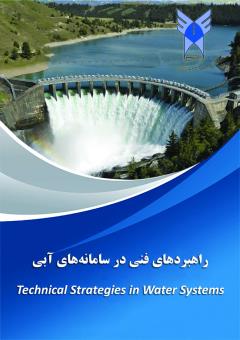استهلاک انرژی جریان در سرریز کلیدپیانویی ذوزنقهای نوع C همراه با جامپ در کلیدهای خروجی آن
محورهای موضوعی : تحلیل، طراحی و ساخت سازه های آبیکاظم جلوب مشالی 1 , علی خوشفطرت 2 * , امیرحسین فتحی 3
1 - دانشکده فنی و مهندسی، دانشگاه آزاد اسلامی، واحد اصفهان (خوراسگان)، اصفهان، ایران.
2 - دانشکده فنی و مهندسی، دانشگاه آزاد اسلامی، واحد اصفهان (خوراسگان)، اصفهان، ایران.
3 - دانشکده عمران و محیط زیست، دانشگاه تربیت مدرس، تهران، ایران.
کلید واژه: استهلاک انرژی, جامپ, سرریز کلیدپیانویی, ضریب آبگذری, کلید خروجی,
چکیده مقاله :
سرریزهای کلیدپیانویی جزء سرریزهای تاجطولانی با پی سبک و دارای ضریب آبگذری بالایی هستند. بهدلیل راندمان بالای این سرریزها؛ لذا راهکار برای افزایش استهلاک انرژی در آنها و در نهایت کاهش آبشستگی بسیار حیاتی است. در این تحقیق از یک سرریز کلیدپیانویی ذوزنقهای شکل همراه با جامپ در کلیدهای خروجی آن به صورت آزمایشگاهی و از سه دبی 03/0، 035/0 و 04/0 متر مکعب بر ثانیه استفاده شد. همچنین از دو جامپ با شعاع 21/0 و 15/0 متر و ارتفاع لبه جامپ برابر 14/0 و 075/0 متر استفاده شد. نتایج نشان که با افزایش شعاع جامپ، میزان استهلاک انرژی در سرریز با شعاع جامپ 21/0 متر و در سرریز با شعاع جامپ 15/0 متر نسبت به سرریز بدون جامپ، بهترتیب حدود 8/3 درصد و 5/2 درصد بیشتر است. همچنین میانگین استهلاک انرژی در سرریزهای با شعاع جامپ برابر 0، 15/0 و 21/0 متر، بهترتیب برابر 1/54، 4/55 و 2/56 درصد است. با افزایش شعاع جامپ و ارتفاع لبه آن، ضریب آبگذری کاهش مییابد. میزان کاهش ضریب آبگذری در سرریز با شعاع جامپ 21/0 و 15/0 متر نسبت به سرریز بدون جامپ، برابر 9/10 درصد و 9/3 درصد است. همچنین در ادامه روابطی برای میزان استهلاک انرژی در سرریزهای معرفی شده، ارائه شد. استفاده از جامپ در کلیدهای خروجی سرریز، چنانچه باعث استهلاک انرژی زیادی نمیشود؛ اما جریان را به جلوتر از پنجه سرریز پرتاب میکند که در بررسی میزان آبشستگی و کاهش آن، میتواند موضوع حائز اهمیتی باشد.
Piano key weirs are a type of long-crested weirs with a light foundation and a high discharge coefficient. Due to the high efficiency of these weirs, it is essential to find ways to increase their energy dissipation and ultimately reduce scour. This study investigated the energy dissipation of piano key weirs with a jump in their outlet keys. A laboratory experiment was conducted using a trapezoidal piano key weir with three discharges of 0.3, 0.35, and 0.4 cubic meters per second. Two jumps with radii of 0.21 and 0.15 meters and jump heights of 0.14 and 0.075 meters were also used. The results showed that the energy dissipation increased with increasing jump radius. The energy dissipation in the weir with a jump radius of 0.21 meters and in the weir with a jump radius of 0.15 meters is approximately 3.8% and 2.5% higher, respectively, than in the weir without a jump. The average energy dissipation in weirs with jump radii of 0, 0.15, and 0.21 meters was 54.1%, 55.4%, and 56.2%, respectively. With increasing jump radius and jump height, the discharge coefficient decreases. The discharge coefficient in piano key weirs with jump radii of 0.21 and 0.15 meters is reduced by 10.9% and 3.9%, respectively, compared to the weir without a jump. The use of a jump in the outlet keys of a weir can throw the flow forward of the weir toe. This can be effective in reducing scour.
Al-Shukur, A. H. K., & Al-Khafaji, G. H. (2018). Experimental study of the hydraulic performance of piano key weir. International Journal of Energy and Environment, 9(1), 63-70.
Bieri, M., Federspiel, M., Boillat, J. L., Houdant, B., Faramond, L., & Delorme, F. (2011). Energy dissipation downstream of Piano key weirs—Case study of Gloriettes Dam (France). Labyrinth and Piano key weirs, 123-130.
Crookston, B. M., Erpicum, S., Tullis, B. P., & Laugier, F. (2019). Hydraulics of labyrinth and piano key weirs: 100 years of prototype structures, advancements, and future research needs. Journal of Hydraulic Engineering, 145(12), 02519004.
Erpicum, S., Laugier, F., Pfister, M., Pirotton, M., Cicero, G. M., & Schleiss, A. J. (Eds.). (2013). Labyrinth and piano key weirs II. CRC Press.
Eslinger, K., & Crookston, B. M. (2020). Energy dissipation of type a piano key weirs. Water, 12(5), 1253.
Fathi, A., Abdi Chooplou, C., & Ghodsian, M. G. (2023). An Experimental Study of Flow Energy Loss in Trapezoidal Stepped Piano Key Weirs (PKWs). Modares Civil Engineering Journal, 23(4), 0-0. (In Persian).
Khanh, M. H. T., Hien, T. C., & Quat, D. S. Study and construction of PK Weirs in Vietnam (2004 to 2011).
Naghibzadeh, S. M., Heidarnezhad, M., Masjedi, A., & Bordbar, A. (2020). Experimental and Numerical Analysis of Energy Dissipation in Piano Key Weirs with Stepped and Baffled Barriers at Downstream Slop. Iranian Journal of Soil and Water Research, 51(10), 2431-2442. (In Persian).
Novák, P., & Čabelka, J. (1981). Models in hydraulic engineering: Physical principles and design applications. Monographs & surveys in water resources engineering.
Ribeiro, M. L., Boillat, J. L., Schleiss, A., Laugier, F., & Albalat, C. (2007). Rehabilitation of St-Marc dam. Experimental optimization of a piano key weir. In Proc. of 32nd Congress of IAHR. Vince. Italy.
Sajadi, S. M. (2017). Effect of baffled outlet keys at Piano Key Weir on dissipating energy. Irrigation and Drainage Structures Engineering Research, 18(69), 77-92. (In Persian).
Singh, D., & Kumar, M. (2022). Gene expression programming for computing energy dissipation over type-B piano key weir. Renewable Energy Focus, 41, 230-235.
Sumer, B. M., & Fredsoe, J. (1991, August). Onset of scour below a pipeline exposed to waves. In ISOPE International Ocean and Polar Engineering Conference (pp. ISOPE-I). ISOPE.

